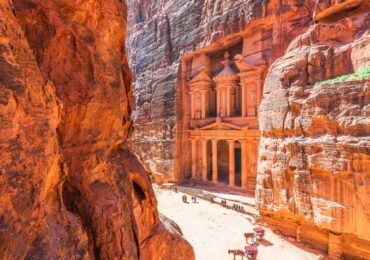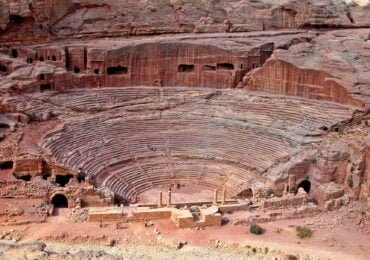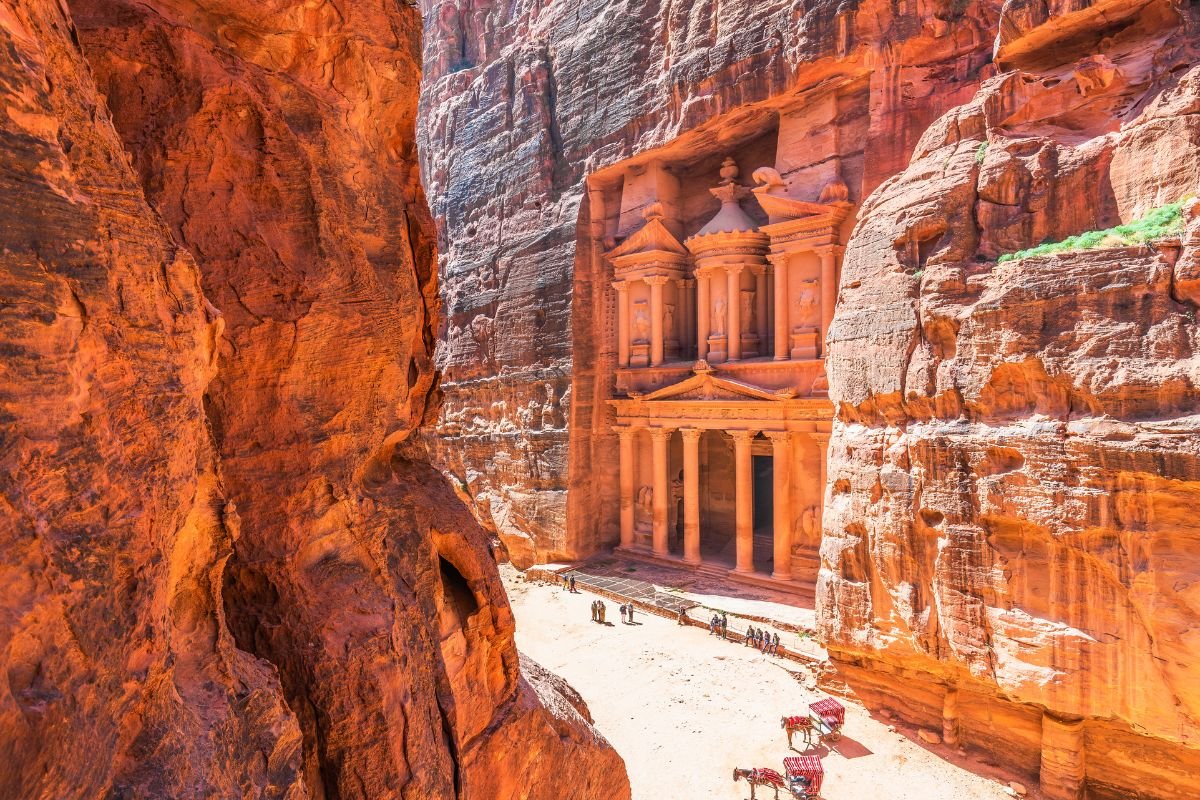Unveiling the Enigmatic Beauty of Petra: A Journey Through Time and Stone
Petra, nestled within the unforgiving desert expanse of southern Jordan lies a city hewn into the vibrant rose-red cliff. A striking testament to the boundless ingenuity and unyielding perseverance of humanity. Petra, bestowed with the honor of being a UNESCO World Heritage Site and recognized as one of the New Seven Wonders of the World. It has enthralled the minds of wanderers across centuries. Join us on an expedition through the annals of time and solid rock, peeling back the layers of mystery enshrouding this ancient marvel crafted by the Nabataean civilization.
Transport yourself to an era where the resonance of lively marketplaces and the rhythmic hoofbeats of caravans reverberated through the narrow canyons of a clandestine city, draped in the hues of rose-red. Our narrative commences in the embrace of Jordan’s desolate landscapes, unveiling Petra, aptly named the “Rose City,” as a living testament to the resourcefulness and tenacity of the Nabataean people. Throughout this odyssey through time, we will meticulously unveil the intricate layers of Petra’s history, employing a tapestry of data and statistics to shed light on the enduring grandeur that continues to captivate the global imagination.
Chapter 1: The Lost City of Petra
According to legend, Petra’s origins can be traced back as early as 312 BCE,. Though it truly came into prominence during the 1st century CE when it became the distinguished capital of the Nabataean Kingdom. Positioned strategically between the Red Sea and the Dead Sea, this bustling trade hub played a pivotal role as a nexus for caravans transporting a bounty of spices, silks, and precious stones. Concealed within a labyrinth of narrow canyons and encircled by towering cliffs, the city earned the evocative title of “The Rose City” owing to the distinctive color of the rock that forms its foundation.

The roots of Petra delve into the 4th century BCE when it functioned as a modest trading post for the Nabataeans—an adept Arab community well-versed in navigation and commerce. Flourishing at the crossroads of major caravan routes, Petra evolved into the preeminent capital of the Nabataean Kingdom during the 1st century BCE. Insights gleaned from archaeological excavations expose the intricate facets of this once-thriving metropolis, showcasing advanced water management systems, ingenious architectural marvels, and a diverse populace engaged in trade with distant realms such as Rome, Egypt, India, and China.
Chapter 2: The Numbers Behind the Beauty of Petra
Petra’s magnificence extends far beyond mere aesthetics; it serves as a resounding testament to the engineering prowess of its ancient inhabitants. Delicately carved into the rosy sandstone canvas, the city unveils more than 800 individual monuments, among them the illustrious Al-Khazneh (The Treasury) and the Monastery. The intricate details etched into these structures narrate a compelling tale of masterful craftsmanship and artistic expression.
Drawing insights from the Petra Archaeological Park, the data underscores the sheer scale and precision of Petra’s architectural marvels. Al-Khazneh, Petra’s foremost iconic structure and also recognized as The Treasury, stands tall as an embodiment of Nabataean craftsmanship. Hewn into the rose-red cliffs, this temple served as a mausoleum for Nabataean kings. The provided data sheds light on the meticulous hands that shaped these rock-cut structures, with Al-Khazneh alone soaring to an impressive height of 40 meters.
Additional insights from UNESCO further emphasize the monumental significance of Al-Khazneh, offering a glimpse into the level of skill and dedication involved in creating this awe-inspiring piece of ancient architecture.
Petra’s prosperity was intricately tied to its role as a vital hub along the Silk and Spice Routes. The data on the vast quantities of frankincense, myrrh, spices, and other exotic goods traded in Petra unveil its economic significance in the ancient world. The Nabataeans’ ability to control and tax these lucrative trade routes fueled the city’s growth and adorned it with architectural wonders.
Chapter 3: The Decline and Rediscovery
Despite its prosperity, Petra’s decline was inevitable. The shift in trade routes, earthquakes, and changing political landscapes contributed to the city’s downfall. By the 4th century CE, Petra had largely faded from historical records, its once-bustling streets abandoned.
For centuries, Petra remained lost to the world, hidden beneath layers of sand and time. Its grandeur became the stuff of legend, with only whispers of the city’s existence surviving in local folklore and the writings of early explorers.
In 1812, Petra reemerged from the shadows, thanks to the Swiss explorer Johann Ludwig Burckhardt. Disguised as an Arab scholar, Burckhardt embarked on a perilous journey through the region, guided only by vague accounts of Petra’s possible location.
During his quest, Burckhardt stumbled upon a narrow gorge, the Siq, which led to the awe-inspiring reveal of Al-Khazneh. The rediscovery of Petra captured the imagination of the Western world, sparking renewed interest in archaeology and the mysteries of ancient civilizations.
Chapter 4: Petra in the Modern Era
Today, Petra stands as a UNESCO World Heritage Site and a symbol of Jordanian national pride. The data on tourism reveals a steady increase in visitors each year, drawn to Petra’s enigmatic charm. The ongoing conservation efforts by organizations like the Petra National Trust safeguard the ancient city for future generations, ensuring that its history continues to be explored and celebrated.
Chapter 5: The Tourism Impact on Petra
In recent years, Petra has experienced a surge in tourism, drawing adventurers, historians, and curious minds from across the globe. In 2019 alone, the site welcomed over 1 million visitors, contributing significantly to Jordan’s tourism industry.
While Petra’s archaeological significance is immeasurable, the economic impact of tourism is tangible. The influx of visitors breathes life into local businesses, from artisan markets offering handmade trinkets to hospitality establishments providing a haven for weary travelers. The economic boost generated by tourism contributes significantly to the livelihoods of those residing in the nearby town of Wadi Musa.
Chapter 6: Petra’s Cultural Significance
Beyond the architectural marvels and tourist influx, Petra holds profound cultural significance. Its intricate rock-cut tombs and temples offer insights into the religious practices and societal structure of the Nabataeans. Petra’s inclusion on UNESCO’s list of World Heritage Sites underscores its global importance as a cultural treasure.
Things to do in Petra
1: The Al-Khazneh Experience
No trip to Petra is complete without standing in awe before the iconic Al-Khazneh, The Treasury. According to visitor statistics from the Petra Archaeological Park, this monumental façade, carved into the sandstone cliffs, attracts hundreds of thousands of visitors annually. As sunlight dances on its intricate columns and sculptures, consider embarking on a guided tour to unravel the mysteries behind this architectural masterpiece.
2: Traversing the Siq

The journey to Petra’s heart unfolds through the Siq, a narrow gorge that serves as the grand entrance to the ancient city. Statistics show that thousands tread this mystical path daily, their anticipation building as the towering cliffs slowly unveil the hidden wonders beyond. Engage in a sensory experience as the narrow pathway guides you towards Al-Khazneh, promising a dramatic revelation that will leave an indelible mark on your travel memories.
3: Climbing to the Monastery
Venture beyond the bustling center of Petra and ascend the rugged terrain to discover the Monastery (Ad Deir), a monumental structure perched atop the cliffs. According to trail usage data, the journey to the Monastery offers a quieter, more serene experience, with fewer visitors. As you reach the summit, the panoramic views of Petra’s intricate landscapes and the distant desert horizon unfold, making the trek well worth the effort.
4: Nabataean Theatre and Royal Tombs

Explore the architectural prowess of the Nabataeans at the Nabataean Theatre, where statistics reveal the site’s popularity for its well-preserved grandeur. Then, wander among the Royal Tombs, carved into the cliffs with intricate details. These structures, which include the Urn Tomb and the Corinthian Tomb, provide a glimpse into the ancient Nabataean funerary practices and are a photographer’s dream.
5: Supporting Conservation Efforts
While reveling in Petra’s wonders, consider participating in responsible tourism. The Petra National Trust actively engages in conservation efforts, ensuring that the ancient city endures for future generations. By contributing to initiatives that promote sustainable tourism, you become a custodian of Petra’s legacy.
Conclusion:
As we traverse the rose-red canyons of Petra, the amalgamation of history, artistry, and unwavering human determination permeates the air. The inclusion of statistics and data only serves to deepen the appreciation for this age-old marvel, a city suspended in time yet animated by the footsteps of contemporary explorers. Petra extends an invitation not only to witness its enchanting beauty but also to actively partake in its preservation, ensuring that its narrative remains eternally vibrant.
Petra stands resolute as a testament to human accomplishment and resilience, its rose-red walls resonating with the echoes of ancient civilizations. However, as present-day adventurers follow the trails of those who came before, the mantle of responsibility for safeguarding this marvel for the future rests squarely in our hands. By embracing mindful tourism practices and fostering a collective dedication to conservation, we can pledge to weave Petra’s enchantment through the tapestry of time, captivating the hearts of those eager to unravel the mysteries of the past.
Enjoy touring Jordan and Petra with our Egypt & Jordan Tours.

